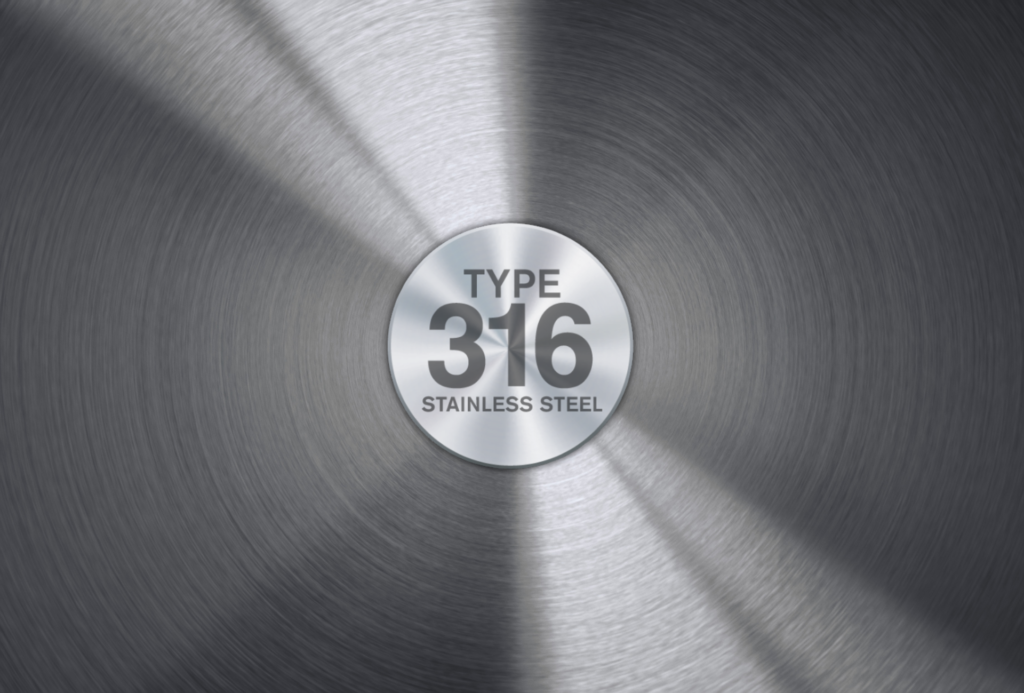
316 Stainless Steel – Properties, Dimensions & Industrial Applications
316 stainless steel is one of the most widely used austenitic stainless steels known for its exceptional corrosion resistance, high strength, and durability. It contains molybdenum (Mo), which significantly improves its resistance to chlorides and harsh environments, making it ideal for marine, chemical, and pharmaceutical applications.
What is 316 Stainless Steel?
316 stainless steel is an austenitic grade of steel in the 300 series, consisting mainly of iron, chromium, nickel, and molybdenum. It is commonly used in corrosive environments due to its enhanced pitting and crevice corrosion resistance compared to 304 stainless steel.
Key Features:
Excellent resistance to chlorides and marine environments
Superior strength at elevated temperatures
Non-magnetic in annealed condition
Good weldability and formability
Hygienic and easy to clean
Chemical Composition of 316 Stainless Steel
| Element | Content (%) |
|---|---|
| Chromium (Cr) | 16.0 – 18.0 |
| Nickel (Ni) | 10.0 – 14.0 |
| Molybdenum (Mo) | 2.0 – 3.0 |
| Manganese (Mn) | ≤ 2.0 |
| Silicon (Si) | ≤ 0.75 |
| Carbon (C) | ≤ 0.08 |
| Phosphorus (P) | ≤ 0.045 |
| Sulfur (S) | ≤ 0.03 |
| Iron (Fe) | Balance |
Mechanical Properties of 316 Stainless Steel
| Property | Value |
|---|---|
| Density | 8.00 g/cm³ |
| Tensile Strength (UTS) | 515 – 620 MPa |
| Yield Strength (0.2% PS) | ≥ 205 MPa |
| Elongation at Break | ≥ 40% |
| Modulus of Elasticity | ~193 GPa |
| Hardness (Brinell) | ≤ 217 HB |
| Impact Strength | 100 – 180 J (at room temp) |
Physical Properties of 316 Stainless Steel
| Property | Value |
|---|---|
| Melting Point | 1371 – 1399 °C |
| Thermal Conductivity | 16.3 W/m·K (at 100 °C) |
| Specific Heat Capacity | 500 J/kg·K |
| Electrical Resistivity | 740 nΩ·m |
| Coefficient of Expansion | 16.0 µm/m·K (0–100 °C) |
316 vs 316L Stainless Steel – What’s the Difference?
| Feature | 316 Stainless Steel | 316L Stainless Steel |
|---|---|---|
| Carbon Content | ≤ 0.08% | ≤ 0.03% |
| Weldability | Moderate | Excellent |
| Corrosion Resistance | High | Slightly better in welds |
| Applications | General industrial | Pharmaceutical, Food, etc. |
316L is preferred when welding is required to reduce the risk of sensitization (intergranular corrosion).
Dimensional Standards & Product Forms
Common Product Forms:
Pipes & Tubes (Seamless & Welded)
Sheets & Plates
Bars & Rods (Round, Square, Hex)
Fittings & Flanges
Valves & Fasteners
Pipe Size Chart (in mm)
| Nominal Pipe Size (NPS) | Outer Diameter (OD) | Wall Thickness (Schedule 40) |
|---|---|---|
| 1/2″ | 21.3 mm | 2.77 mm |
| 1″ | 33.4 mm | 3.38 mm |
| 2″ | 60.3 mm | 3.91 mm |
| 4″ | 114.3 mm | 6.02 mm |
| 6″ | 168.3 mm | 7.11 mm |
Plate Thickness Range:
0.5 mm to 100 mm (custom options available)
Bar Diameter Range:
Round Bar: 6 mm to 300 mm
Square/Hex: As per ASTM A276/A479
Applications of 316 Stainless Steel
316 SS is used where enhanced corrosion resistance is critical:
Marine Industry: Shipbuilding, seawater piping, propeller shafts
Pharmaceuticals: Hygienic piping, reactors, cleanroom fittings
Food & Dairy: Sanitary valves, storage tanks, dairy equipment
Chemical Processing: Tanks, heat exchangers, process piping
Oil & Gas: Downhole tubing, offshore platforms
Architecture: Coastal structures, facades, railings
Medical Devices: Surgical instruments, implants (in certain grades)
Advantages of 316 Stainless Steel
Excellent corrosion resistance to salts and acids
Performs well in low and high temperatures
High formability and machinability
Long service life with minimal maintenance
Suitable for hygiene-critical environments
Corrosion Resistance in Harsh Environments
316 stainless steel is superior in:
Marine environments (resistance to chlorides and saltwater)
Chemical and acidic processing plants
Industrial atmospheres with high humidity or salinity
Corrosion Resistance in Harsh Environments
316 stainless steel is superior in:
Marine environments (resistance to chlorides and saltwater)
Chemical and acidic processing plants
Industrial atmospheres with high humidity or salinity
International Standards for 316 Stainless Steel
| Standard | Specification |
|---|---|
| ASTM A240 | Plates, sheets, and strips |
| ASTM A312 | Pipes (welded/seamless) |
| ASTM A276 | Bars and shapes |
| ASTM A213 | Boiler and heat exchanger tubes |
| DIN EN 1.4401 | European designation |
| JIS SUS316 | Japanese standard |
Final Thoughts
If your project demands strong corrosion resistance, hygiene, or marine-grade durability, 316 stainless steel is the ideal choice. With unmatched performance in aggressive environments and a wide range of available forms, it remains a preferred material in many critical sectors.
